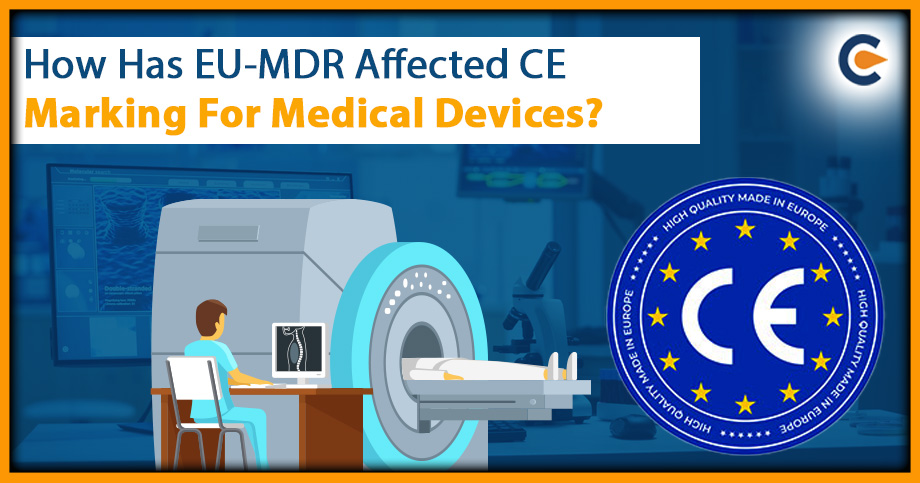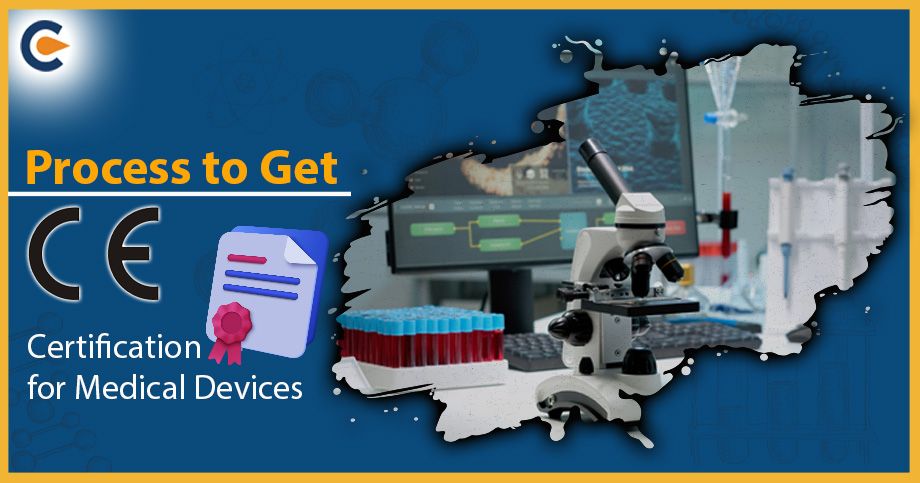The CE mark is required for all products sold on the European Union market. The European Union and an authorized representative of the EU approved the EU-2017/745[1] medical device rule on April 5, 2017, to address gaps and enhance the security, effectiveness, and efficiency of medical devices sold in the EU. A medical gadget needs to have the CE marking in order to be marketed across all EU markets. The Canadian Standards Association is only consulted when a company decides that the product complies with the relevant requirements. The manufacturer is in charge of appropriate use; no specific authority has responsibility over the CE designation. All devices, regardless of whether they are currently on the market or not, must adhere to this guideline. In this blog, we will discuss how EU-MDR has affected CE Marking for Medical Devices.
What Is CE Marking For Medical Devices As Per EU MDR?
The French term for European conformance is “Conformité Européenne,” which the CE stands for. It is a specific kind of declaration that the manufacturer makes to attest to the fact that their product conformed to the EU-MDR. The manufacturer’s medical device may be sold in any EU member state with the CE mark. So, whether inside or outside of the EU, it is the manufacturer’s responsibility to obtain CE marking for their product. The CE mark is not the same as the quality mark; it is a verification that the product complies with EU-MDR 2017/745. Manufacturers still have to adhere to the device’s requirements for efficacy, performance, and quality.
Products That Require a CE Mark –
- Toys,
- Protective Equipment,
- Electronics,
- Eyewear,
- Machinery, and Medical Devices
Effect of EU-MDR on CE Marking for Medical Devices
The MDR is more thorough and detailed than MDD, hence there are many differences between the two. MDR makes sure that medical devices are safe, of a high standard, transparent to consumers, and subject to heightened market oversight. It also ensures that all medical device producers have equal access to all EU markets. The following list of MDR modifications and how they may impact the CE marking for medical devices procedure is provided:
Reclassification
- Medical devices are categorized under EU-MDR based on the danger they pose. Determining the process for CE marking for Medical Devices benefits from this. MDR classifies medical equipment from class I through class III generally the same way, but EU-MDR reclassifies several devices. Manufacturers must therefore precisely categorize their products going forward and decide which conformance path to take. Hence, technical and clinical data were required for reclassified devices that were put in the higher group due to their risk as they might not already be accessible.
- A notified body must be involved in order for manufacturers of high-risk class devices, such as class IIa, class IIb, and class III, to receive the conformity assessment.
- To obtain the CE marking for medical devices, the manufacturer of class I devices may self-certify.
- Reusable class 1 devices, cosmetic implants, and items without intentional medical use are also subject to the revised responsibilities (described in MDR Annex XVI). Manufacturers must correctly categorize their goods and decide whether additional conformity assessment pathways are necessary. This is a problem when devices are reclassified into a group with a greater risk profile since it calls for clinical and technical information that might not be readily available.
- The MDR law has an impact on manufacturers as well as their partners in business, such as the businesses who are involved in the supply chain for the products. This includes product wholesalers and importers, who are specifically governed by MDR Article 25. (In addition to Articles 13 and 14). Additionally, as outlined in MDR Article 11, EU Authorized Representatives (EUAR) is subject to extra strict criteria.
- EUAR partners must be registered, and possess the necessary people, regulatory processes, and liability insurance. A Person Responsible for Regulatory Compliance (PRRC) must be appointed for manufacturers and EUAR entities, according to MDR Article 15. This person must either possess the necessary academic credentials in an applicable scientific field and at least one year of professional experience, or four years of professional experience. Although they are exempt from needing a permanent PRRC job, micro and small businesses are nonetheless required to always have access to a qualified applicant.
Technical Documentation
Technical files, often known as design dossiers, are crucial to medical device regulation. This documentation ought to show regulatory compliance and provide a thorough description of the item. The function, design, intended use, clinical assessment, and claims related to a medical device are all covered in depth in a technical file. The MDR calls for a fundamental change to the way technical file generation is currently done. Requirements have been based on the most recent GHTF (Global Harmonization Task Force) STED guidance document in order to standardize the technical documentation needed by international regulators.
Safety and performance requirements (MDR Annex I) have taken the place of essential requirements (ERs) in the MDD. The relevant requirements must be determined by manufacturers, who must then use technical, clinical, and risk management data to guarantee compliance. The presumption of conformity continues to apply to devices that are in compliance with the harmonized standards (outlined in MDR Article 8). Nonetheless, the European Commission may establish common specifications in cases where harmonized standards are absent or insufficient.
Clinical Evaluation Reports (CERs)
CERs are documents that include clinical information pertaining to medicine. Regarding clinical evidence and evaluation, the MDR provides clearer information (MDR Annex XIV, Part A). After the implementation of this law, notified organizations have enhanced their inspection of CER and tightened the requirements for using scientific material to establish equivalency. It is crucial for manufacturers to ensure that CERs meet the new requirements, especially for class I medical devices.
Also, it is anticipated that Notified Bodies will examine CERs more closely (NBs). Manufacturers need to check the CERs in their development and legacy portfolios to make sure they meet the latest requirements. This is crucial in situations when post-market surveillance initiatives have produced additional data and the initial CE marking was supported by limited clinical evidence. A summary of safety and clinical performance for devices with high-risk profiles (such as class III or implanted devices) must be put together and submitted to the European Data Bank on Medical Devices (EUDAMED) database (MDR Article 32).
Validity of CE Marking for Medical Devices
The validity of CE marking for medical devices issued before the MDR’s full implementation in May 2021 is four years. After MDR implementation, certificates are issued and are valid for three years. It can be up to a year for some high-risk devices.
When applying the CE mark, bear the following in mind:
- It must be clear, readable, and durable.
- The initials “CE” must be the same vertical size and cannot be smaller than 5mm (unless specified).
- If the CE marking for medical devices is clear, the maker may utilize it in different forms.
Let’s say the manufacturer is unable to mark the medical device with the CE mark. If so, it can be attached to any packing or included with the documents. Let’s say the device is governed by multiple EU directives. Documents must then state that the equipment complies with all relevant regulations in that situation.
Conclusion
In response to changes in the scientific and technological environment influencing the medical device sector, the MDR constitutes a substantial shift in approach to regulating medical devices. To give producers time to adapt, the regulation will be implemented gradually over a three-year transition period. According to the new rule 2017/745, all medical device products must get CE marking for medical devices in order to gain access to the EU market. Both products that are actively being developed and those that are already on the market are impacted by this responsibility.
Also Read:
Process To Get CE Certification For Medical Devices
Procedure To Obtain CE Mark For Medical Devices In India – An Overview











